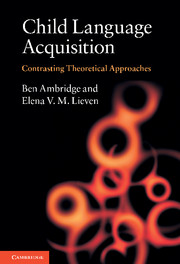Book contents
- Frontmatter
- Contents
- List of figures
- List of tables
- List of boxes
- List of summary tables
- Preface
- Acknowledgements
- 1 Introduction
- 2 Speech perception, segmentation and production
- 3 Learning word meanings
- 4 Theoretical approaches to grammar acquisition
- 5 Inflection
- 6 Simple syntax
- 7 Movement and complex syntax
- 8 Binding, quantification and control
- 9 Related debates and conclusions
- Notes
- References
- Author index
- Subject index
3 - Learning word meanings
Published online by Cambridge University Press: 05 June 2012
- Frontmatter
- Contents
- List of figures
- List of tables
- List of boxes
- List of summary tables
- Preface
- Acknowledgements
- 1 Introduction
- 2 Speech perception, segmentation and production
- 3 Learning word meanings
- 4 Theoretical approaches to grammar acquisition
- 5 Inflection
- 6 Simple syntax
- 7 Movement and complex syntax
- 8 Binding, quantification and control
- 9 Related debates and conclusions
- Notes
- References
- Author index
- Subject index
Summary
Introduction
At the same time as they are parsing the continuous speech stream into individual words (Chapter 2), children must learn the meanings of these words. This chapter investigates different proposals for how they do this.
Initially, it may seem as if there is no question to answer. One might imagine that the child's caregiver simply produces a word (e.g. rabbit) and points out the object that this word denotes (e.g. a rabbit that is running past). A problem with this account is that such ‘teaching’ is virtually impossible for word types such as abstract nouns (e.g. happiness), non-actional verbs (e.g. watching), prepositions (e.g. in) and determiners (e.g. the) (Tomasello, 2003). Another problem (Quine, 1960) is that if a child's mother (or a speaker attempting to teach his or her own language to a foreign linguist) produces a word (e.g. gavagai) as a rabbit runs past, the range of potential meanings is virtually infinite. Of course, gavagai could mean rabbit, but it could equally mean leg, white, furry (a part or property of the rabbit), animal, rodent, Flopsy (an object name, but at a different level of specificity), running, fleeing, chasing (the action of the rabbit), pointing, looking, catch it! (actions involving the speakers) or even grass, field or Today is Tuesday (something not connected to the rabbit at all).
- Type
- Chapter
- Information
- Child Language AcquisitionContrasting Theoretical Approaches, pp. 61 - 102Publisher: Cambridge University PressPrint publication year: 2011



